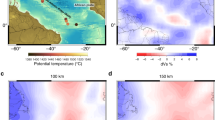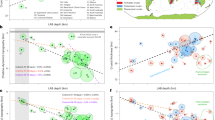Abstract
Prominent crustal lineations straddle the Reykjanes ridge, south of Iceland (Fig. 1). These giant V-shaped features are thought to record temporal variations in magma production at the Reykjanes ridge axis, associated with along-axis flow of Icelandic plume material1. It has been proposed that this flow is channelled preferentially along the ridge axis2,3,4, and that temporal variability is induced by fluctuations of the Iceland plume itself1,4,5,6,7 or, alternatively, by relocations of the ridge axis on Iceland8. Here I present a geodynamic model that predicts the formation of crustal V-shaped ridges from a pulsing and radially flowing mantle plume. In this model, plume pulses produce mantle temperature perturbations that expand away from the plume in all directions beneath the zone of partial melting. The melting zone has a high viscosity owing to mantle dehydration at the onset of partial melting9. This high-viscosity region allows for reasonable variations in crustal thickness, produces crustal Vs that extend hundreds of kilometres along the axis, and prevents the plume material from being preferentially channelled along the ridge axis. The angle of the crustal V-shaped features relative to the ridge axis reflects the rate of lateral plume flow, which remains several times greater than the ridge half-spreading rate over the length of a crustal V. Consequently, this radially expanding plume produces lineations in crustal thickness and free-air gravity anomalies that appear to be nearly straight.
This is a preview of subscription content, access via your institution
Access options
Subscribe to this journal
Receive 51 print issues and online access
$199.00 per year
only $3.90 per issue
Buy this article
- Purchase on Springer Link
- Instant access to full article PDF
Prices may be subject to local taxes which are calculated during checkout




Similar content being viewed by others
References
Vogt, P. R. Asthenosphere motion recorded by the ocean floor south of Iceland. Earth Planet. Sci. Lett. 13, 153–160 (1971).
Schilling, J.-G. Upper mantle heterogeneities and dynamics. Nature 314, 62–67 (1985).
Vogt, P. R. Plumes, subaxial pipe flow, and topography along the mid-ocean ridge. Earth Planet. Sci. Lett. 29, 309–325 (1976).
White, R. S., Brown, J. W. & Smallwood, J. R. The temperature of the Iceland plume and origin of outward propagating V-shaped ridges. J. Geol. Soc. Lond. 152, 1039–1045 (1995).
Hanan, B. B. & Schilling, J.-G. The dynamic evolution of the Iceland mantle plume: the lead isotope perspective. Earth Planet. Sci. Lett. 151, 43–60 (1997).
Schilling, J.-G. & Noe-Nygaard, A. Faeroe-Iceland plume: Rare-earth evidence. Earth Planet. Sci. Lett. 24, 1–14 (1974).
Schilling, J. G., Meyer, P. S. & Kingsley, R. H. Evolution of the Iceland hotspot. Nature 296, 313–320 (1982).
Hardarson, B. S., Fitton, J. G., Ellam, R. M. & Pringle, M. S. Rift relocation—a geochemical and geochronological investigation of a paleo-rift in northwest Iceland. Earth Planet. Sci. Lett. 153, 181–196 (1997).
Hirth, G. & Kohlstedt, D. L. Water in the oceanic upper mantle: Implications for rheology, melt extraction, and the evolution of the lithosphere. Earth Planet. Sci. Lett. 144, 93–108 (1996).
Ito, G., Lin, J. & Gable, C. W. Dynamics of mantle flow and melting at a ridge-centered hotspot: Iceland and the Mid-Atlantic Ridge. Earth Planet. Sci. Lett. 144, 53–74 (1996).
Ito, G., Shen, Y., Hirth, G. & Wolfe, C. Mantle flow, melting, and dehydration of the Iceland mantle plume. Earth Planet. Sci. Lett. 165, 81–96 (1999).
Gable, C. W. Numerical Models of Plate Tectonics and Mantle Convection in Three Dimensions. Thesis, Harvard Univ. (1989).
Feigner, M. A. & Richards, M. A. The fluid dynamics of plume-ridge and plume-plate interactions: an experimental investigation. Earth Planet. Sci. Lett. 129, 171–182 (1995).
Ribe, N., Christensen, U. R. & Theissing, J. The dynamics of plume-ridge interaction. 1. Ridge-centered plumes. Earth Planet. Sci. Lett. 134, 155–168 (1995).
Allen, R. M. et al. The thin hot plume beneath Iceland. Geophys. J. Int. 137, 51–63 (1999).
Wolfe, C., Bjarnason, I. T., VanDecar, J. C. & Solomon, S. C. Seismic structure of the Iceland mantle plume. Nature 385, 245–247 (1997).
Menke, W., Brandsdóttir, B., Einarsson, P. & Bjarnason, I. Th. Reinterpretation of the RRISP-77 Iceland shear-wave profiles. Geophys. J. Int. 126, 166–172 (1996).
Staples, R. K. et al. Färoe-Iceland ridge experiment. 1. Crustal structure of northeastern Iceland. J. Geophys. Res. 102, 7849–7866 (1997).
Vogt, P. R. in Structure and development of the Greenland-Scotland Ridge, New Methods and Concepts (eds Bott, M. H. P., Saxov, S., Talwani, M. & Thiede, J.) 191–213 (Plenum, New York, 1983).
Scott, D. R., Stevenson, D. J. & Whitehead, J. A. Jr Observations of solitary waves in a viscously deformable pipe. Nature 319, 759–761 (1986).
Olson, P. & Christensen, U. Solitary wave propagation in a fluid conduit within a viscous matrix. J. Geophys. Res. 91, 6367–6374 (1986).
McDougall, I., Kristjansson, L. & Saemundsson, K. Magnetostratigraphy and geochronology of northwest Iceland. J. Geophys. Res. 89, 7029–7060 (1984).
Watkins, N. D. & Walker, G. P. L. Magnetostratigraphy of eastern Iceland. Am. J. Sci. 277, 513–584 (1977).
Albers, M. Channeling of plume flow beneath mid-ocean ridges. Earth Planet. Sci. Lett. 187, 207–220 (2001).
Cannat, M. et al. Mid-Atlantic Ridge–Azores hotspot interactions: along-axis migration of a hotspot-derived event of enhanced magmatism 10 to 4 Ma ago. Earth Planet. Sci. Lett. 173, 257–269 (1999).
Vogt, P. R. Global magmatic episodes: new evidence and implications for the steady-state mid-oceanic ridge. Geology 7, 93–98 (1979).
Sandwell, D. & Smith, W. H. F. Marine gravity from Geosat and ERS-1 altimetry. J. Geophys. Res. 102, 10039–10054 (1997).
DeMets, C., Gordon, R. G., Argus, D. F. & Stein, S. Effect of recent revisions to the geomagnetic reversal time scale on estimates of current plate motions. Geophys. Res. Lett. 21, 2191–2194 (1994).
McKenzie, D. & Bickle, M. J. The volume and composition of melt generated by extension of the lithosphere. J. Petrol. 29, 625–679 (1988).
Parker, R. L. The rapid calculation of potential anomalies. Geophys. J. R. Astron. Soc. 31, 447–455 (1973).
Wessel, P. & Smith, W. H. F. New version of the Generic Mapping Tools released. Eos 76, 329 (1995).
Author information
Authors and Affiliations
Corresponding author
Rights and permissions
About this article
Cite this article
Ito, G. Reykjanes 'V'-shaped ridges originating from a pulsing and dehydrating mantle plume. Nature 411, 681–684 (2001). https://doi.org/10.1038/35079561
Received:
Accepted:
Published:
Issue Date:
DOI: https://doi.org/10.1038/35079561
Comments
By submitting a comment you agree to abide by our Terms and Community Guidelines. If you find something abusive or that does not comply with our terms or guidelines please flag it as inappropriate.



